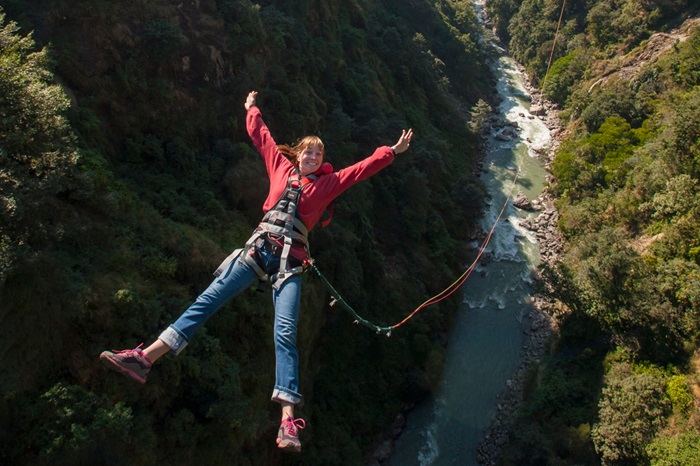Bungee jumping, the thrilling activity where participants leap from great heights while attached to an elastic cord, is often perceived as dangerous and potentially painful. However, with proper equipment and techniques, bungee jumping is designed to be both safe and exhilarating. This article delves into the science and safety measures behind bungee jumping, explaining how this adrenaline-pumping activity avoids causing harm to participants.
The History and Evolution of Bungee Jumping
Bungee jumping has its roots in ancient traditions but has evolved significantly over the years. Understanding its history helps in appreciating the advanced safety measures in place today.
The Origins of Bungee Jumping
Bungee jumping’s origins can be traced back to the “land divers” of Pentecost Island in Vanuatu. This ritual involved men leaping from wooden towers with vines tied to their ankles. The modern sport of bungee jumping was popularized in the late 20th century, thanks to the daring stunts of the Oxford University Dangerous Sports Club and subsequent commercialization by A.J. Hackett.
Evolution of Safety Measures
The safety of bungee jumping has come a long way since its inception. Modern bungee jumping employs sophisticated equipment, rigorous testing, and stringent safety protocols. These advancements ensure that participants experience the thrill without risking injury.
The Mechanics of Bungee Jumping
Understanding the mechanics of bungee jumping is crucial to comprehending how it minimizes the risk of injury. The equipment, physics, and techniques all play a vital role in ensuring a safe jump.
The Role of the Bungee Cord
The bungee cord is the heart of bungee jumping. Made from multiple strands of latex rubber, the cord is highly elastic and capable of absorbing significant forces. The cord’s elasticity ensures a smooth deceleration, preventing the jarring stop that would occur with a non-elastic rope.
The Physics of Bungee Jumping
The physics of bungee jumping involves complex calculations to ensure safety. Factors such as the jumper’s weight, jump height, and cord length are meticulously considered. The cord’s elasticity allows it to stretch and absorb kinetic energy, reducing the impact on the jumper’s body.
Safety Harness and Equipment
Modern bungee jumping utilizes advanced harnesses and safety equipment. Full-body harnesses distribute the force of the jump across the body, minimizing stress on any single part. Additionally, backup safety systems are in place to ensure redundancy and mitigate the risk of equipment failure.
Psychological Preparation and Safety Briefing
A critical aspect of bungee jumping safety is the psychological preparation of participants. Proper mental preparation can reduce anxiety and ensure a safer experience.
The Importance of Mental Readiness
Mental readiness is crucial for a successful bungee jump. Participants are often given a thorough briefing to prepare them for the experience. This includes understanding the jump process, safety protocols, and what to expect during the jump.
The Safety Briefing
Before any jump, participants undergo a comprehensive safety briefing. This includes instructions on how to position their bodies during the jump, how to handle the recoil, and what to do in case of an emergency. Ensuring that jumpers are well-informed contributes significantly to their safety.
Medical Considerations and Health Precautions
While bungee jumping is generally safe, certain medical conditions may pose risks. It is essential for participants to be aware of these considerations and take appropriate precautions.
Medical Conditions and Bungee Jumping
Certain medical conditions, such as heart problems, epilepsy, and high blood pressure, may increase the risk of injury during bungee jumping. It is vital for individuals with such conditions to consult a medical professional before attempting a jump.
see also: How Do You Get Back Up After Bungee Jumping?
Health Screening and Waivers
Reputable bungee jumping operators conduct health screenings and require participants to sign waivers. These measures ensure that individuals are physically fit for the activity and understand the inherent risks.
Common Myths and Misconceptions
Bungee jumping is often surrounded by myths and misconceptions. Debunking these can help alleviate unnecessary fears and provide a clearer understanding of the activity’s safety.
Myth: Bungee Jumping Causes Severe Whiplash
One common myth is that bungee jumping causes severe whiplash. In reality, the elasticity of the bungee cord reduces the risk of such injuries by providing a gradual deceleration. Proper body positioning and high-quality equipment further mitigate this risk.
Myth: The Bungee Cord Can Snap Easily
Another misconception is that the bungee cord can snap easily. In reality, bungee cords are designed to withstand forces far greater than those exerted during a jump. They undergo rigorous testing and regular inspections to ensure their integrity.
The Role of Professional Operators
The expertise and professionalism of bungee jumping operators are critical to ensuring safety. Reputable operators adhere to strict standards and protocols to protect participants.
Training and Certification of Instructors
Professional bungee jumping operators employ highly trained and certified instructors. These experts have extensive knowledge of the equipment, safety procedures, and emergency protocols. Their presence and guidance are vital to ensuring a safe and enjoyable experience for participants.
Regular Equipment Maintenance
Reputable operators prioritize regular maintenance and inspection of their equipment. Bungee cords, harnesses, and other safety gear are routinely checked for wear and tear, ensuring that they meet the highest safety standards.
Conclusion: The Thrill Without the Risk
Bungee jumping, when conducted with proper equipment, training, and safety measures, is a safe and exhilarating activity. The combination of advanced technology, thorough training, and stringent protocols ensures that participants can enjoy the thrill without fear of injury. By understanding the science and safety behind bungee jumping, adventurers can embrace this extreme sport with confidence and excitement.
related topics:
- What Factors Have To Be Taken Into Consideration When A Person Wants To Go Bungee Jumping?
- What Country Made Bungee Jumping Popular In The 1980’S?
- Top 10 Highest Bungee Jumping In The World

